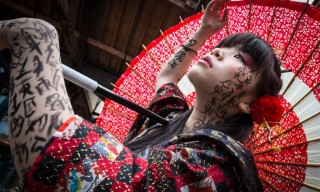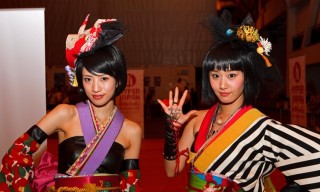Loading
Search
▼ From Kawaii To Fairy Kei: Fashion Goes Beyond The Kimono At Hyper Japan
- Category:Other
Now in its tenth year, the three-day festival is a place for J-fashion enthusiasts to socialise, show off their outfits and get inspiration for future looks
Ten years after it started in 2010, the UK’s largest celebration of traditional and modern Japanese culture, is returning to London today for three days.
Hyper Japan, which is now a twice-yearly event, offers traditional food, anime merchandise and a cosplay zone, as well as an array of attractions for fashion lovers. The Asakusa culture section will be home to the vintage kimono brand Fuji Kimono, where guests can buy traditional Japanese clothing.
Although the kimono may be Japan’s most recognisable garment, plenty more styles and style tribes have come out of Harajuku, Tokyo’s fashion district. Harajuku is also the name Hyper Japan has given to its fashion zone, which includes brands from the UK and beyond, selling “kawaii” – meaning cute – clothes, accessories and other merchandise.
Kawaii is a subculture in Japan, characterised by pastel colours, soft fabrics and adorable mascots. Hello Kitty, Aggretsuko and Gudetama are just a few of the characters from the genre that have made their way into western culture. Some of the most popular Japanese fashions are lolita, fairy kei and decora. Lolita takes various forms, one of which is “elegant gothic lolita”, inspired, in part, by rococo-era fashion. Fairy kei involves layering pastels on pastels with cute motifs, such as moons, stars, sweets and teddy bears. Decora is an explosion of bright colours and accessories, making wearers look like walking rainbows.
“Kawaii culture and J-fashion has always been an aspect of the event we’ve fostered and encouraged, with exhibitors such as Tofu Cute and the J-fashion community,” says festival director Ken dos Remedios. “When we started in 2010, it was a minor subculture that only a few knew about.
Since then, it’s grown to where most of our attendees know about it and it has a strong following on social media. We’ve noticed it moving from a subculture enjoyed by a minority in the know, to a subculture with the ability to influence fashion beyond its immediate community.”
Kiri Raimona from Tofu Cute, a kawaii store based in the UK, says: “Kawaii culture has boomed over the past 10 years, with exposure to all things kawaii becoming more accessible than ever before. People of all ages are exploring bright colours and cute characters, adapting them into their everyday lives.” This year, there is a new addition to the fashion and kawaii zone – the Hyper Kawaii Contest. Artists and crafters have been given the chance to submit their handmade kawaii or Japan-inspired work via Instagram in the months leading up to the event. The finalists’ work will be on display for festival visitors to vote on, and the winner will receive prizes including a kawaii subscription box service and an instant camera.
The festival also provides a place for J-fashion enthusiasts to socialise, show off their outfits and get inspiration for future looks. On Saturday and Sunday, there will be two fashion shows featuring festival attendees who were selected by organisers after submitting their looks online. The J-Style Collection fashion show has previously featured guests from Japan, such as fashion designer Kurebayashi, who is also a model for yamikawaii (“dark cute”) brand Listen Flavor.
Ten years after it started in 2010, the UK’s largest celebration of traditional and modern Japanese culture, is returning to London today for three days.
Hyper Japan, which is now a twice-yearly event, offers traditional food, anime merchandise and a cosplay zone, as well as an array of attractions for fashion lovers. The Asakusa culture section will be home to the vintage kimono brand Fuji Kimono, where guests can buy traditional Japanese clothing.
Kawaii is a subculture in Japan, characterised by pastel colours, soft fabrics and adorable mascots. Hello Kitty, Aggretsuko and Gudetama are just a few of the characters from the genre that have made their way into western culture. Some of the most popular Japanese fashions are lolita, fairy kei and decora. Lolita takes various forms, one of which is “elegant gothic lolita”, inspired, in part, by rococo-era fashion. Fairy kei involves layering pastels on pastels with cute motifs, such as moons, stars, sweets and teddy bears. Decora is an explosion of bright colours and accessories, making wearers look like walking rainbows.
“Kawaii culture and J-fashion has always been an aspect of the event we’ve fostered and encouraged, with exhibitors such as Tofu Cute and the J-fashion community,” says festival director Ken dos Remedios. “When we started in 2010, it was a minor subculture that only a few knew about.
Since then, it’s grown to where most of our attendees know about it and it has a strong following on social media. We’ve noticed it moving from a subculture enjoyed by a minority in the know, to a subculture with the ability to influence fashion beyond its immediate community.”
Kiri Raimona from Tofu Cute, a kawaii store based in the UK, says: “Kawaii culture has boomed over the past 10 years, with exposure to all things kawaii becoming more accessible than ever before. People of all ages are exploring bright colours and cute characters, adapting them into their everyday lives.” This year, there is a new addition to the fashion and kawaii zone – the Hyper Kawaii Contest. Artists and crafters have been given the chance to submit their handmade kawaii or Japan-inspired work via Instagram in the months leading up to the event. The finalists’ work will be on display for festival visitors to vote on, and the winner will receive prizes including a kawaii subscription box service and an instant camera.
The festival also provides a place for J-fashion enthusiasts to socialise, show off their outfits and get inspiration for future looks. On Saturday and Sunday, there will be two fashion shows featuring festival attendees who were selected by organisers after submitting their looks online. The J-Style Collection fashion show has previously featured guests from Japan, such as fashion designer Kurebayashi, who is also a model for yamikawaii (“dark cute”) brand Listen Flavor.
- July 13, 2019
- Comment (0)
- Trackback(0)




